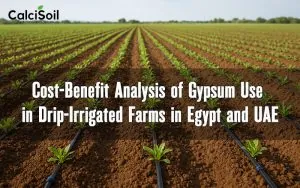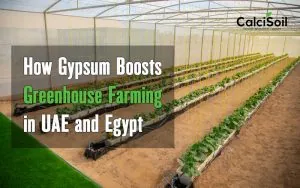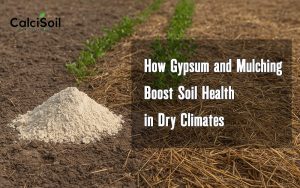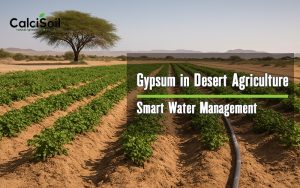
Phosphorus is essential for crop growth—but when it escapes from farm fields into nearby rivers and lakes, it can trigger serious environmental issues. Algae blooms, poor water quality, and fish die-offs are just a few consequences of phosphorus runoff. Fortunately, there’s a powerful, natural solution that more farmers are discovering: agricultural gypsum.
In this article, we’ll explore how gypsum fertilizer helps reduce phosphorus runoff, improves soil structure, and ultimately supports sustainable agriculture.
Understanding the Problem: Phosphorus Runoff
Phosphorus is commonly applied to fields as part of NPK fertilizer blends. While it’s vital for plant development, only a portion of it gets absorbed by crops. The rest can attach to soil particles and be carried away by rain, especially in fields with poor structure or compacted layers. This runoff contaminates nearby waterways and contributes to nutrient pollution—a growing global concern.
Traditional solutions include cover cropping, buffer zones, and controlled fertilizer timing. However, many farmers overlook one of the most cost-effective tools available: agricultural gypsum.
What is Agricultural Gypsum?
Agricultural gypsum is a naturally occurring mineral—calcium sulfate dihydrate (CaSO₄·2H₂O)—used as a gypsum fertilizer. Unlike lime, gypsum doesn’t change soil pH, but it offers key nutrients: calcium and sulfur. These minerals are essential for healthy root development and soil balance.
More importantly, gypsum improves soil aggregation, allowing better water infiltration and reducing surface runoff. This characteristic makes it particularly useful in mitigating phosphorus loss.

The Science Behind Gypsum and Phosphorus Retention
Research from institutions like the USDA and land-grant universities has shown that applying gypsum to farm soils significantly reduces phosphorus runoff. But how?
Here’s what happens:
- Improved Soil Structure: Gypsum helps bind soil particles into stable aggregates. This reduces surface sealing and increases water infiltration, meaning less runoff carries phosphorus away.
- Calcium Binding Effect: The calcium in gypsum can react with soluble phosphorus to form less-soluble compounds. These stay in the soil longer, making phosphorus available for crops instead of rivers.
- Reduction of Particulate Loss: Many phosphorus molecules are attached to fine soil particles. Since gypsum reduces erosion and particle movement, fewer particles—and less phosphorus—leave the field.
Field Studies and Real Results
In a multi-state study funded by the USDA, gypsum application led to up to 50% reduction in dissolved phosphorus runoff in treated fields. Trials across Ohio, Indiana, and Iowa demonstrated that fields receiving gypsum not only retained more nutrients but also showed improved crop performance over time.
Farmers also reported better soil tilth and water penetration after gypsum use—especially in no-till systems where compaction can be a challenge.

Applying Gypsum Fertilizer: Best Practices
To get the most benefit from gypsum fertilizer, farmers should follow a few key guidelines:
- Application Rate: A typical rate is 1 to 2 tons per acre, depending on soil type and phosphorus levels.
- Timing: Apply before expected rainy seasons or after harvest to stabilize soil structure.
- Consistency: Annual or biennial applications can maintain long-term benefits.
Gypsum can be spread using standard lime or fertilizer spreaders. It’s compatible with no-till, cover cropping, and other regenerative practices.
Environmental and Economic Benefits
Reducing phosphorus runoff isn’t just good for the environment—it can also improve farm economics.
- Fewer Inputs Wasted: More phosphorus stays where it’s needed—in the soil.
- Reduced Fertilizer Costs: Over time, gypsum can make nutrients more available, meaning less need for frequent applications.
- Increased Market Access: As sustainability becomes a purchasing factor, farms with environmentally friendly practices may gain access to premium markets or subsidies.
By adding agricultural gypsum to their soil health toolkit, farmers can improve productivity while protecting natural resources.
Why More Farmers Are Turning to Gypsum
Sustainable agriculture isn’t just a trend—it’s a necessity. With changing weather patterns, stricter environmental regulations, and increasing demand for clean food production, farmers need tools that balance productivity with stewardship.
Gypsum fertilizer offers a rare win-win: enhanced soil performance and environmental protection. As research continues to validate its benefits, its adoption is growing worldwide.
Whether you’re managing a large commercial operation or a small family farm, gypsum is a smart investment in the future of your soil—and your bottom line.
Final Thoughts
Phosphorus runoff is a complex issue, but agricultural gypsum provides a practical, science-backed solution. By improving soil structure, reducing erosion, and binding nutrients where they belong, gypsum helps farmers meet both their crop goals and their environmental responsibilities.
If you’re looking to enhance your field performance while protecting local waterways, it might be time to consider adding gypsum fertilizer to your soil management plan.







